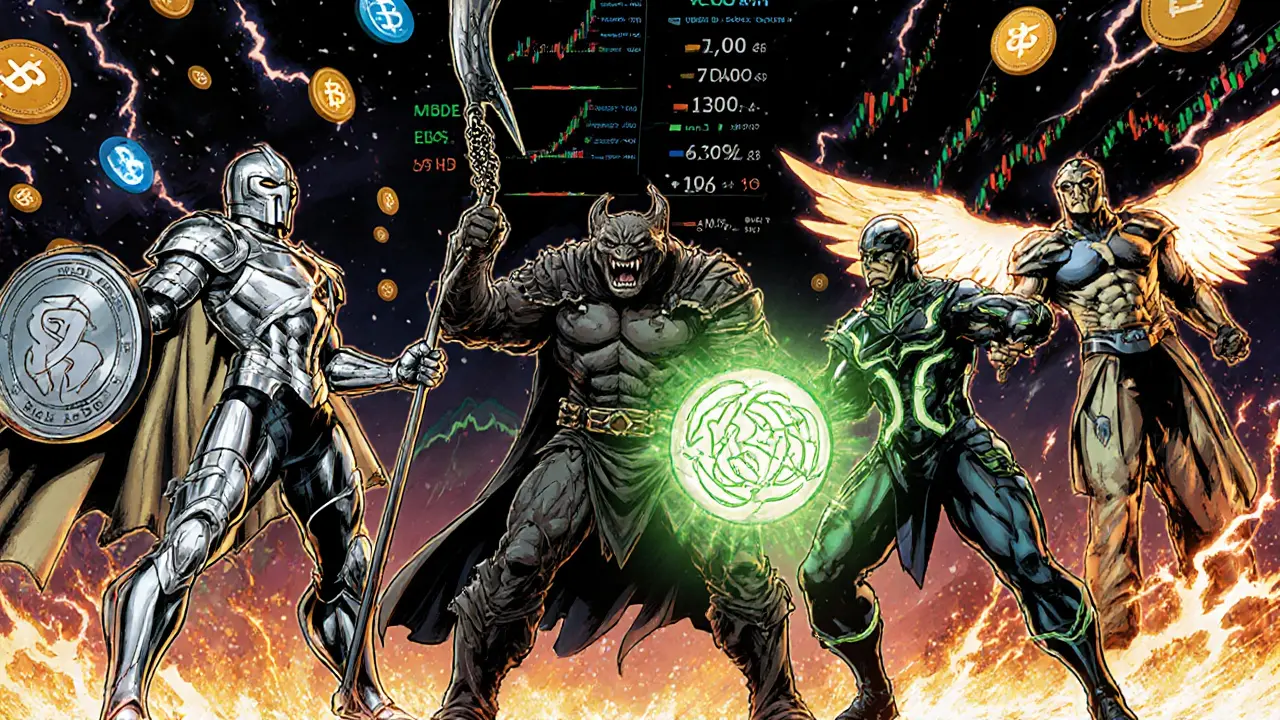Stablecoin Strategy Advisor
Recommended Stablecoins
Your personalized recommendations based on your strategy:
Stablecoin Comparison Chart
USDC
0-0.5% APYFiat-backed, highest liquidity
USDT
0-0.5% APYHighest volume, centralized
DAI
2-4% APYDecentralized, over-collateralized
USDe
8-15% APYSynthetic yield engine
FRAX
2-4% APYHybrid backing model
Quick Takeaways
- DAI offers the most decentralised $1 peg, ideal for permissionless DeFi.
- USDC provides unbeatable liquidity on centralized and decentralized exchanges.
- USDT remains the highest‑volume stablecoin but carries centralisation risk.
- USDe (Ethena) delivers 8‑15% APY through a synthetic, delta‑neutral strategy.
- FRAX is the only practical hybrid stablecoin, blending collateral and algorithmic components.
Picking the best stablecoins for DeFi and crypto trading isn’t just about who has the biggest market cap. You need to balance liquidity, decentralisation, yield potential, and regulatory risk. Below we break down the leading options in 2025, show where each shines, and give you a cheat‑sheet you can start using today.
What Makes a Stablecoin “Best” for DeFi?
Three technical pillars drive a stablecoin’s suitability:
- Backing mechanism - fiat‑collateralised, crypto‑backed, synthetic or hybrid.
- Liquidity depth - how much volume it commands on DEXs and CEXs.
- Risk profile - centralisation, smart‑contract exposure, and regulatory scrutiny.
Understanding these factors lets you match a coin to a specific strategy, whether you’re farming yield, swapping large volumes, or simply parking cash between trades.
Fiat‑Backed Leaders: USDC and USDT
USDC is a USD‑backed stablecoin issued by the Centre consortium (Circle and Coinbase) with monthly attestations from Grant Thornton. With over $30billion in circulation and listings on every major exchange, USDC enjoys the deepest order books, sub‑0.01% slippage on most pairs, and near‑instant settlement on both Ethereum and its native layer‑2s.
Regulators favour USDC because its reserve reports are public and its custodianCircle is subject to U.S. AML/KYC rules. The trade‑off? Circle can freeze addresses, a point that makes risk‑averse DeFi users keep only a modest amount on‑chain.
USDT is the oldest fiat‑collateralised stablecoin, launched by Tether in 2014, backing each token with a mix of cash, short‑term deposits and commercial paper. USDT dominates trading volume - roughly 70% of all stablecoin swaps on DEX aggregators - and its liquidity reach spans 13 blockchains.
The downside is transparency. Although Tether now publishes audited snapshots, the mix of assets and occasional legal disputes keep some DeFi participants wary.
Crypto‑Backed Decentralisation Champion: DAI
DAI is a decentralized, crypto‑backed stablecoin created by MakerDAO that maintains its $1 peg through over‑collateralisation (minimum 150% collateral ratio) and autonomous smart contracts. As of October2025, DAI powers more than 400 DeFi protocols and holds roughly $8billion in total value locked.
Because no single entity controls DAI, it tolerates censorship‑resistant use‑cases like permissionless lending on Aave or collateral on Compound. The trade‑off: minting DAI requires users to lock ETH or other assets in a Collateralized Debt Position (CDP), and volatile markets can trigger liquidation if collateral falls below the safety margin.
For traders who need a stablecoin that can survive a firewall‑style shutdown or a U.S. regulatory clamp‑down, DAI remains the go‑to choice.
Synthetic Yield Engine: USDe (Ethena)
USDe is a synthetic stablecoin from the Ethena protocol that blends Ethereum (ETH) collateral with perpetual futures contracts to generate a delta‑neutral yield. Launched in 2024, USDe now offers 8‑15% APY depending on the market, making it one of the highest‑earning stablecoins available.
USDe’s architecture means you earn yield while the token stays pegged to $1, but you also inherit the smart‑contract risk of Ethena’s vaults. Institutional investors are starting to allocate up to 5% of their stablecoin basket to USDe for that extra yield boost.
If you’re comfortable navigating a slightly more complex UI (most users access USDe through Curve’s “Ethena” pool or Aave’s integrated gateway), USDe can turn an otherwise flat staking position into a revenue‑generating asset.

Hybrid Option: FRAX
FRAX is a hybrid stablecoin that combines a partially collateralised reserve (about 80%) with algorithmic supply adjustments to stay at $1. After the TerraUSD crash, FRAX raised its collateral ratio to improve stability, and its market cap now sits around $800million.
FRAX offers modest yields (around 2‑4% APY) via its own farming incentives, and because it isn’t fully fiat‑backed it sidesteps some regulatory hurdles. However, its algorithmic component still introduces a small peg‑risk, especially during extreme market stress.
For a balanced approach-decentralisation + some fiat safety-FRAX is worth a small allocation in a diversified stablecoin portfolio.
How to Choose the Right Stablecoin for Your Strategy
| Coin | Backing Type | Liquidity (24h Volume) | Typical Yield | Decentralisation Rating | Regulatory Risk |
|---|---|---|---|---|---|
| USDC | Fiat‑collateralised | $12B+ | 0‑0.5% (savings accounts) | Low (central custodian) | Medium‑High (KYC, freeze risk) |
| USDT | Fiat‑collateralised (mixed assets) | $15B+ | 0‑0.5% | Low (central custodian) | Medium (transparency concerns) |
| DAI | Crypto‑backed (over‑collateralised) | $2B+ | 2‑4% (savings via MakerDAO vaults) | High (DAO governance) | Low‑Medium (no central custodian) |
| USDe | Synthetic (ETH + futures) | $300M+ | 8‑15% (protocol‑generated) | Medium‑High (smart‑contract risk) | Medium (newer regulatory focus) |
| FRAX | Hybrid (partial fiat + algorithmic) | $150M+ | 2‑4% (farm incentives) | Medium (partial DAO control) | Low‑Medium (reduced algorithmic exposure) |
Use the table as a quick reference, then dive deeper into the sections below to see how each coin behaves in real‑world scenarios.
DeFi Use‑Cases and the Ideal Stablecoin
- Yield Farming & Staking: USDe shines with 10‑15% APY, followed by DAI’s 2‑4% on Maker vaults. Pair USDe with a low‑slippage pool on Curve to maximise returns.
- Liquidity Provision on AMMs: USDC and USDT dominate Curve and Uniswap pools, giving you the tightest spreads for large swaps.
- Collateral for Lending/Borrowing: DAI is preferred on Aave and Compound because it’s fully permissionless. USDC works too but adds centralized exposure.
- Cross‑Chain Swaps: When moving assets between Ethereum, Solana, and Avalanche, USDC’s bridge support via Circle’s native bridge offers the lowest fees; FRAX and DAI work on most major bridges but may incur higher costs.
Risk Management Tips
1. Diversify. Hold at least two fiat‑backed coins (USDC/USDT) for liquidity, one decentralized coin (DAI) for permissionless contracts, and a small slice of USDe for yield.
2. Monitor peg health. Use platforms like DeBank or CoinGecko to see real‑time price deviations. A deviation of >0.2% often signals an arbitrage opportunity.
3. Set liquidation safeguards. If you mint DAI, enable auto‑liquidation thresholds on MakerDAO’s dashboard to avoid forced sells during market crashes.
4. Stay updated on regulation. MiCA in the EU and the upcoming U.S. stablecoin bill may affect USDC/USDT usage for Institutional traders.
Practical Walkthrough: Swapping $10,000 via Curve
- Connect your wallet (MetaMask, Rainbow, or Ledger).
- Select the “Stablecoins” pool on Curve’s interface.
- Deposit $10,000 USDT and choose USDe as the target token.
- Review the estimated slippage - usually <0.05% for this volume.
- Confirm the transaction; thanks to EIP‑4844, gas should be under 30k gas (~$0.30).
- Stake the received USDe into the Ethena‑Curve pool to start earning the 12% APY.
This sequence lets you turn a high‑liquidity fiat‑backed coin into a yield‑bearing synthetic coin without leaving the Curve ecosystem.
Future Outlook: What’s Next for Stablecoins?
Two trends will shape the next wave:
- Hybrid & Synthetic Growth. Ethena’s USDe and emerging “fractionally‑collateralised” projects aim for $10B+ market caps by 2026, challenging fiat dominance.
- Regulatory Clarity. As MiCA matures and the U.S. drafts its stablecoin law, compliant coins like USDC will see institutional inflows, while truly permissionless options like DAI may gain broader acceptance in jurisdictions with lighter oversight.
Keep an eye on MakerDAO’s Sky upgrade (Q22025) - it promises lower gas fees and faster oracle updates, which could make DAI even more attractive for high‑frequency trading.

Frequently Asked Questions
Is DAI really stable during market crashes?
DAI’s over‑collateralisation means it stays pegged as long as the collateral pool is healthy. During extreme drops, MakerDAO’s liquidation engine sells off excess collateral, which can cause short‑term price deviations but the peg usually recovers within hours.
Can I earn yield on USDC without locking it up?
Yes. Several platforms (e.g., BlockFi, Nexo) offer interest‑bearing accounts for USDC, typically 0.5‑1% APY. These are custodial, so you trade off higher yield for reduced control.
What’s the biggest risk with USDe?
Smart‑contract risk. If Ethena’s vault code has a bug or an oracle fails, USDe could temporarily lose its peg or incur losses. Use reputable aggregators (Curve, Aave) to mitigate exposure.
Should I keep any stablecoins on a centralized exchange?
Only the amount you need for active trading. Keeping large balances on‑chain (USDC, DAI) reduces custody risk and gives you instant access to DeFi protocols.
How do I move USDe to another blockchain?
Use a cross‑chain bridge that supports Ethena, such as Symbiosis or Wormhole. The process typically involves locking USDe on the source chain and receiving a wrapped version on the destination chain, with fees under 0.1%.


Hardik Kanzariya
December 30, 2024 AT 05:35Hey everyone, great rundown on the stablecoins! If you’re just starting out, try pairing a low‑risk USDC with a modest DAI position – it keeps your capital safe while you get a taste of DeFi. Remember, diversification isn’t just a buzzword; it’s a habit that can save you from sudden market shocks. Keep experimenting, and you’ll find the mix that fits your style.
Kyle Hidding
January 5, 2025 AT 11:18Honestly, this piece reads like a PR brochure. The APY numbers are cherry‑picked, the risk assessments are superficial, and the whole “synthetic yield engine” hype is just a veneer for speculative contracts. Anyone still trusting the jargon‑filled hype train will get burned when the next protocol audit fails.
victor white
January 11, 2025 AT 17:02One must contemplate the ontological ramifications of anchoring our financial sovereignty to fiat‑backed monoliths; the specter of centralized control looms large. Yet, the cryptographic over‑collateralisation of DAI offers a tantalising glimpse of libertarian decentralisation, albeit imperfect.
mark gray
January 17, 2025 AT 22:45I think the key is to keep things simple: use USDC for everyday swaps and DAI when you need a permission‑less platform. Both are solid choices without overcomplicating your strategy.
Alie Thompson
January 24, 2025 AT 04:28It is incumbent upon every conscientious participant in the crypto ecosystem to recognise that financial instruments are not merely profitable opportunities, but ethical obligations we bear toward the broader community. When we champion a stablecoin without scrutinising its underlying governance, we tacitly endorse opacity and potential exploitation. The allure of high APY on synthetic constructs such as USDe can seduce the unwary, yet it also foments a culture of short‑term gain over long‑term stability. Moreover, the concentration of reserve assets in fiat‑backed tokens like USDC and USDT raises questions about systemic risk, especially when regulatory scrutiny intensifies. It is morally indefensible to overlook the implications of centralized custodians holding the keys to our digital wealth. Each transaction we execute ripples through a network of stakeholders, from retail investors to institutional actors, and our collective choices shape the regulatory narrative. By diversifying across decentralized options like DAI, we empower a governance model that is transparent and resistant to unilateral control. Simultaneously, allocating a modest portion to innovative hybrids such as FRAX can hedge against both fiat and algorithmic volatility. The responsible path forward demands continuous education, vigilant monitoring of peg health, and an unwavering commitment to decentralisation principles. Let us not be seduced solely by headline‑grabbing yields; let us instead champion a resilient, inclusive, and ethically grounded DeFi future.
Samuel Wilson
January 30, 2025 AT 10:12For those seeking a measured approach, consider allocating 60 % of your stablecoin holdings to USDC for liquidity, 30 % to DAI for decentralised exposure, and the remaining 10 % to USDe if you are comfortable with the associated smart‑contract risk. This allocation balances liquidity, decentralisation, and yield potential.
Rae Harris
February 5, 2025 AT 15:55Honestly, the whole "USDe is the ultimate yield machine" narrative feels like hype culture. If you’re comfortable with the risk, go ahead, but otherwise stick with the low‑key DAI pool.
Aditya Raj Gontia
February 11, 2025 AT 21:38The stablecoin landscape is fine, but the article could’ve cut the fluff. USDC, USDT, DAI, USDe, FRAX – that’s basically it.
Kailey Shelton
February 18, 2025 AT 03:22Nice summary.
mannu kumar rajpoot
February 24, 2025 AT 09:05While you’re busy praising USDT’s volume, remember the hidden cabal that governs its reserve disclosures. Ignoring that means you’re essentially walking into a trap set by the same oligarchs who manipulate fiat markets.
Tilly Fluf
March 2, 2025 AT 14:48I appreciate the thorough analysis presented herein. It would be prudent for investors to heed the nuanced risk assessments outlined, particularly concerning regulatory developments within the European Union.
Darren R.
March 8, 2025 AT 20:32Wow-another “miracle” yield! 🙄 Honestly, “8‑15% APY” is the crypto version of the Pied Piper’s promise-beware the inevitable crash that follows such lofty claims!!!
Jack Fans
March 15, 2025 AT 02:15Hey, I think you missed mentioning the tiny fee differences on Curve when swapping between USDC and USDe… Also, the UI on Ethena can be a bit confusing, but it’s not a dealbreaker. Sorry if there are a few typos, I’m writing fast…
Ayaz Mudarris
March 21, 2025 AT 07:58Colleagues, let us contemplate the epistemic foundations of our asset allocation choices. By interrogating the underlying mechanisms of each stablecoin, we empower ourselves to navigate the volatile seas of DeFi with confidence and purpose.
Vaishnavi Singh
March 27, 2025 AT 13:42The philosophical underpinning of a decentralized stablecoin like DAI aligns with the principle of self‑sovereignty, offering an elegant solution to the trust problem inherent in fiat‑backed alternatives.
Linda Welch
April 2, 2025 AT 19:25Oh, great, another article telling us to “diversify”. As if we’re all sitting on a couch in America sipping lattes while the rest of the world watches the dollar crumble. The so‑called “regulatory risk” is just a euphemism for governments trying to yank the rug out from under us. Meanwhile, the hype machines keep pumping USDe’s absurd APYs, luring naïve users into a false sense of security. And don’t even mention the hidden fees on cross‑chain bridges-those cost more than a decent dinner. If you’re going to chase 15 % yields, you might as well invest in a pyramid scheme, because that’s basically the same risk profile. Bottom line: the whole stablecoin narrative is a mirage, and anyone buying into it is either gullible or willfully ignorant.
meredith farmer
April 9, 2025 AT 01:08The elite media push USDe as a “risk‑free” wonder, but they conveniently ignore the dark side of synthetic yield-namely, the untold exploits hidden in the code. Wake up, people.
Peter Johansson
April 15, 2025 AT 06:52Great insights! 😊 Remember to keep an eye on the peg health and don’t over‑allocate to any single coin. Happy farming! 🚀
Cindy Hernandez
April 21, 2025 AT 12:35If you’re looking for a quick start, the USDC/USDT pair on Uniswap offers the deepest liquidity, while DAI remains the go‑to for permissionless lending protocols.
Gaurav Gautam
April 27, 2025 AT 18:18Balancing liquidity and decentralisation is like walking a tightrope-feel free to experiment with a 70/30 split between USDC and DAI, then adjust based on your comfort with smart‑contract risk. Keep monitoring the market, and you’ll fine‑tune your portfolio over time.
Rebecca Stowe
May 4, 2025 AT 00:02Stay optimistic! Even if markets dip, a well‑diversified stablecoin basket will keep you afloat.
Lara Cocchetti
May 10, 2025 AT 05:35The push for fiat‑backed stablecoins is a covert operation orchestrated by central banks to re‑assert control over the digital economy. Ignoring this agenda means you’re complicit in surrendering financial sovereignty.